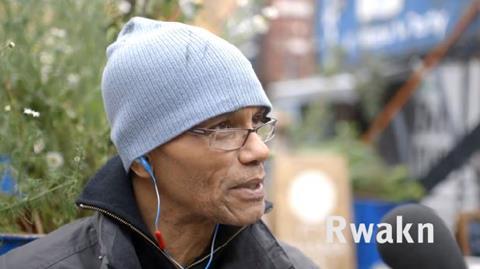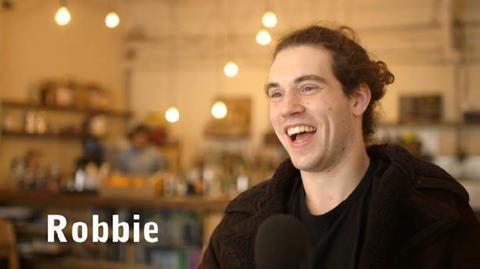Set in Brixton, London, this video lesson includes authentic interviews with people living in London, talking about first impressions.
Note: If your device isn’t Flash compatible, then click on the link under ‘Related files’ at the bottom of the page to download the video. You can then play it through the media player on your device (e.g. iTunes).
Seven ideas on how to use this video with your class
The following lesson ideas can be used alongside the video Live from London: First Impressions. You can use these ideas on their own, or you could group some of the activities together and choose to do them in whichever order you prefer. Each lesson idea has a recommended learner level. The transcript is attached under ‘Related files’ at the bottom of this page.
If you’re teaching teens, you can use these videos alongside the series Impressions. This video can be used with the lesson plan ‘First impressions’.
Some of the ideas can be used for flipped lessons. In this scenario, students can do tasks and preparatory work at home or in the school, independently from the teacher, for the following lesson. This allows more time for communicative tasks, teacher-led tasks or group-led tasks during class time.
1. Vocabulary lesson 1 – Everyday expressions
Level: Intermediate (B1) to upper intermediate (B2)
Summary: Students familiarize themselves with some of the low-frequency everyday English in the video.
Objectives: vocabulary building; speaking practice; inducing meaning from context
Instructions: As the videos are authentic, unscripted interviews, some of the language used by the interviewees is very natural and colloquial.
Write the below words and expressions on the board, or print out the worksheet which can be found under ‘Related files’ at the bottom of this page.
- to make one’s mind up
- a done deal
- to get it from someone
- to talk nonstop
- to come across
- to be blown away
Explain to your students that these expressions are in the video, and as they listen they need to consider what they mean in context. Play the video, and then place your students in groups to see if they can come up with definitions for the new language. If they are still struggling, put the following definitions on the board:
a. to talk without pause or interruption
b. something that has already been decided and won’t change
c. to make a decision
d. the impression you get about someone when you meet them – i.e what you think of their behaviour or appearance
e. when someone makes a big impact on you
f. to have a particular character trait like someone, often a parent or family member
Students match each definition to the correct word.
Answers: 1. c 2. b 3. f 4. a 5. d 6. e
You can then ask your students to discuss the following questions in small groups. You can write them on the board or dictate them.
- Do you make your mind up quickly about someone when you first meet them?
- Is there anyone you would say your impression of is a done deal?
- What do you get from your mum or dad?
- Do you know anyone who talks nonstop?
- How do you think you come across when people first meet you?
- Who was the last person you met who blew you away?
2. Vocabulary lesson 2 – describing people (adjectives)
Level: Pre-intermediate (B1) to upper intermediate (B2)
Summary: Students familiarize themselves with the adjectives used to describe people in the video.
Objectives: listening for specific information; vocabulary building; speaking practice
Instructions: Explain to your students they need write down all the adjectives used to describe character or appearance that they hear in the video. Play the video.
Here is the list:
scruffy
smart
obnoxious
friendly and unfriendly
courteous
smiley
dry
bubbly
cool
approachable
nice
decent
genuine
really, really nice (eyes)
Now ask your students to find the main stress for each adjective, before modelling and drilling the new words. Finally, ask your students to think of someone from their lives who fits with each adjective. Ask your students to note the name of someone next to each adjective and then explain why in pairs or small groups.
3. True or false questions
Level: Pre-intermediate (A2) to intermediate (B1)
Summary: Students are given a list of true or false statements about the video content.
Objectives: listening for specific information
Flipped: Students watch the video at home and prepare their true and false statements outside of class – see the Additional idea below.
Instructions: Look at the statements below. Some are true, and others are false.
You can either write them up on the board or print out the worksheet under ‘Related resources’ at the bottom of this page. You may wish to change the order of the statements or play the video first to make it more challenging, or you may even wish to make your own true/false statements using the transcript (found at the bottom of this page).
Please note that the answers are also given in this list.
- Harry first notices people’s hair. [F] He first notices their attitude.
- Harry takes after his father. [F] He takes after his mother.
- Robbie first notices if people are friendly and smiley. [T]
- Robbie asks a lot of questions when he first meets someone. [T]
- Lorraine thinks people first notice that she’s funny. [F] Bubbly.
- Harry thinks people first notice his voice. [T]
- Rwakn thinks people first notice his eyes. [F] He mentions his height and how he doesn’t smile much.
- Robbie says he often stops talking. [F] He talks non-stop.
- Lorraine hopes people feel she’s a genuine person. [T]
- The first thing Robbie noticed about his best friend was her eyes. [T]
Additional idea: Ask your students to write their own true and false statements, to swap with a partner, about what they first notice about others and what others first notice about them.
4. Themed discussion
Level: Pre-intermediate (A2) to intermediate (B1)
Summary: Students use the main questions from the video and some additional questions as a basis for a personalised discussion about ‘first impressions’.
Flipped: Your students could do the preparatory work at home and prepare answers and some further questions to bring to class the following day.
Objectives: discussion; fluency practice
Instructions: Place your students into pairs or small groups for this activity.
Before playing the video, tell your students that Luke, the presenter/interviewer in the video, asks people about first impressions. Ask your students to note down all the questions they hear in the video. Explain that there are three questions (see list below).
What do you first notice about people?
What do people first notice about you?
What did you first notice about your best friend?
Now ask the students to discuss the questions in small groups.
Further potential discussion questions:
Do you think you judge people too easily?
Do you think people judge you too easily?
Are your first impressions normally right or wrong?
Do you think people judge too early?
Do you judge people on social networks like Facebook and Instagram?
5. Note-taking on first impressions
Level: Pre-intermediate (A2) to intermediate (B1)
Summary: Students watch the video and write down notes on a chosen interviewee.
Objectives: listening for specific information; giving opinions; agreeing and disagreeing
Flipped: Preparation for the lesson can be done at home to bring to class the following day.
Instructions: Place your students into groups of four. Give each student in their groups the name of a different interviewee from the video:
- Harry
- Rwakn
- Robbie
- Lorraine
Explain that as they watch the video they have to make detailed notes on their impressions of their person. You could write these prompts on the board:
What’s the first thing you notice about them?
What do you think of them?
Do you think they seem friendly or unfriendly?
Would you like to meet them?
What kind of job do you think they have?
Play the video.
Now ask your students to share their opinions in their groups.
Play the video again to consolidate the shared information.
Finally, ask your students whether they agree or disagree with their group’s impressions. They can discuss this in their small groups.
6. First impressions: look, seem, look like
Level: Intermediate (B1) to upper intermediate (B2)
Summary: Students watch the video after completing this lesson: http://www.onestopenglish.com/teenagers/impressions/first-impressions/
Objectives: further practice of look, seem and look like from the ‘First impressions’ lesson; agreeing and disagreeing
Instructions: Write the following table up on the board:
| PERSON | Harry | Rwakn | Robbie | Lorraine |
|---|---|---|---|---|
|
looks |
||||
|
seems |
||||
|
looks like |
Ask students to do the same on a piece of paper or on their computers, or use the worksheet found under ‘Related resources’ at the bottom of this page.
Now play the video. After viewing the video ask your students to fill in the table, practicing looks, seems, looks like and any further language taken from the first impressions lesson.
Once completed, ask students to compare their tables in small groups. Do they agree or disagree? Finally, ask your students what person they would most like to meet from the video.
7. Real-life first impressions
Level: Pre-intermediate (A2) to upper intermediate (B2)
Summary: Outside the classroom, students go and meet people (either in the school or surrounding area) to write down their first impressions.
Objectives: to engage students; note-taking; speaking
Flipped: This lesson could start in class and be developed into more of a homework project. Once students have gathered their first impresssions and photos/videos, these could be presented in the following class with a Q&A exercise.
Instructions: Play the video to your students as a warmer without instruction. After your students have watched the video, explain that they now have a task to do outside the classroom. Explain that they must go and meet at least four new people. In order to do this, allow the students to work in pairs and come up with some generic questions to ask people, unrelated to the subject. Students could pretend to be interviewing people for a school project, or could even ask for directions. The main point is that they meet someone new and have a first impression of them.
Once they have met and spoken to a new person, ask them to note down their first impressions of that person, considering their appearance, attitude and how they came across in general. Make sure your students either video the people they’re interviewing or take a photo of them.
The following lesson, in class, change pairs and ask them to discuss who they met and what first impressions they had. This could be developed into a small presentation with a Q&A exercise.
Downloads
Click link to download and view these filesLive from London: First Impressions — Worksheet
Word, Size 0.12 mbLive from London: First Impressions — Video
Video, Size 52.48 mbLive from London: First Impressions — Audio
Video, Size 52.48 mbLive from London: First Impressions — Transcript
Word, Size 0.12 mb
Topics
- Adults
- B1
- B2
- British English
- C1
- Celebrations / Holidays / Festivals
- Clothes
- Crafts & Projects
- Culture
- Drink
- Economics
- Education
- ESP
- Facts
- Festivals
- Film & TV
- Food
- Geography & Places
- Health & Well-being
- History
- Integrated Skills
- Intermediate
- Leisure
- Listening
- Mixed Ability
- Nature
- People & Individuals
- Politics
- Pre-Intermediate
- Science
- Shopping
- Social Media
- Sport
- Technology
- Teenagers
- Travel
- Up to 45 mins
- Up to 60 mins
- Upper-Intermediate
- Video
Live from … authentic video lessons

A series of innovative video lessons featuring authentic interviews. We went out and about in London asking members of the public a series of questions and recorded their answers. Each video comes with a set of lesson ideas plus a worksheet with a transcript of each interview for you to ...
- 1
- 2
- 3
- 4
- 5
- 6
- 7
- 8
- 9
- 10
- 11
- 12
- 13
- Currently reading
Live from London: First impressions
- 15






























No comments yet